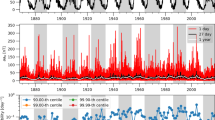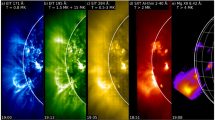Abstract
KNOWLEDGE of the interaction of comets with the solar wind1,2 was greatly advanced during the 1986 passage of comet Halley, which was studied in situ and by remote sensing more thoroughly than any previous comet flyby3,4. Of particular interest and novelty was the large flare5 that Halley was seen to produce on 12 February 1991, when it was 14.3 AU from the Sun and 18° below the ecliptic plane. There have been further outbursts, most recently on 17 March6. We note that the Sun has been unusually active in recent months, and suggest that a shock wave, generated by the solar flare and propagating through the interplanetary medium, could have caused the comet to flare. For example, we show that a solar flare on 31 January could plausibly have produced a shock wave that would have reached Halley on 12 February, and would have been sufficiently strong to crack the comet's crust of fluffy ice.
Similar content being viewed by others
References
Biermann, L. Z. Astrophys. 29, 274 (1951).
Parker, E. N. Interplanetary Dynamical Processes, 12–15 (Interscience, New York, 1963).
Nature 321, 280–368 (1986).
Proc. 20th ESLAB Symp. on the Exploration of Halley's Comet, ESA SP-250 (European Space Agency, 1986).
Nature 349, 732 (1991).
Levi, B. G. Physics Today 44, 20 (1991).
Intriligator, D. S. J. geophys. Res. 82, 603–617 (1977).
Dryer, M. Radio Sci. 8, 893–901 (1973).
Richter, N. B. Astr. Nachrichten 271, 207 (1941).
Dryer, M. et al. J. geophys. Res. 80, 2001–2012 (1975).
Smith, E. J. & Wolfe, J. H. Geophys. Res. Lett. 3, 137–140 (1976).
Weissman, P. R. ESA SP-250, 517–522 (1986).
Smart, D. F. & Shea, M. A. J. geophys. Res. 90, 183 (1985).
Glasstone, S. (ed.) The Effects of Nuclear Weapons. Ch. IV; Ch. VI (Superintendent of Documents, Washington DC, 1962).
Smoluckowski, R. Astrophys. J. 244, L31–L34 (1981).
Donn, B. & Rahe, J. in Comets (ed, Wilkening, L. L.), 203–226 (University of Arizona Press, Tucson, 1982).
Author information
Authors and Affiliations
Rights and permissions
About this article
Cite this article
Intriligator, D., Dryer, M. A kick from the solar wind as the cause of comet Halley's February 1991 flare. Nature 353, 407–409 (1991). https://doi.org/10.1038/353407a0
Received:
Accepted:
Issue Date:
DOI: https://doi.org/10.1038/353407a0
- Springer Nature Limited
This article is cited by
-
Selected phenomena that affect the structure of the cometary landscape
Journal of Astrophysics and Astronomy (2021)
-
A Review of Cometary Outbursts at Large Heliocentric Distances
Earth, Moon, and Planets (2016)
-
The Electrostatic Blow-Off of Cometary Grains and Variations and Outbursts of Brightness of Comets at Large Heliocentric Distances
Astrophysics and Space Science (2004)
-
Some requirements of a colliding comet source of gamma ray bursts
Astrophysics and Space Science (1993)
-
Why did Halley hiccup?
Nature (1991)





